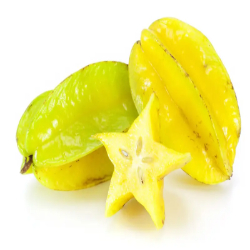Star fruit Nutrition facts
Star fruit

Star fruit, also known as carambola, is a star-shaped tropical fruit with sweet and sour flavor. Carambola is native to the Malayan peninsula and cultivated in many parts of Southeast Asia, Pacific Islands and China for its fruits. Although abundant and plentiful, carambola is yet to gain popularity, especially in the western world.
Scientific name: Averrhoa carambola. The genus Averrhoa includes two well-known sorrels (Oxalidaceae) family of fruiting trees, carambola, and bilimbi (tree cucumber).
The fruit is recognized as belimbing manis or balimbing (filipino) in many South-East Asian regions and kamrakh in India.
Star fruit is a small, bushy evergreen tree that grows very well under hot, humid, tropical conditions. The plant bears small lilac-colored, bell-shaped flowers in clusters which subsequently develop into oblong-shaped fruits with characteristic five angled edges (sides or ribs) that appears like a starfish in cross-sections.
Both sweet and sour varieties begin to yield under cultivable orchards and ready for harvesting when the plants reach about 3-4 years old.
Carambola fruit features light-green to yellow with an attractive smooth, waxy surface and weighs about 70-130g. Inside, its crispy and juicy pulp can either be mildly sweet or extremely sour depending upon the cultivar type and amount of oxalic acid concentration. In some seed varieties, 2-5 tiny edible seeds are found at the center./p>
| Nutrition Principle | Nutrition Value | Percentage of RDA |
|---|---|---|
| Principle | ||
| Energy | 31 Kcal | 1.5% |
| Carbohydrates | 6.73 g | 5% |
| Protein | 1.04 g | 2% |
| Total Fat | 0.33 g | 1% |
| Cholesterol | 0 mg | 0% |
| Dietary Fiber | 2.80 g | 7% |
| Vitamins | ||
| Folates | 12 µg | 3% |
| Niacin | 0.367 mg | 2.25% |
| Pyridoxine | 0.017 mg | 1.5% |
| Riboflavin | 0.016 mg | 1.25% |
| Thiamin | 0.014 mg | 1% |
| Vitamin A | 61 IU | 2% |
| Vitamin C | 34.4 mg | 57% |
| Vitamin E | 0.15 mg | 1% |
| Vitamin K | 0 µg | 0% |
| Electrolytes | ||
| Sodium | 2 mg | 0% |
| Potassium | 133 mg | 3% |
| Minerals | ||
| Calcium | 3 mg | 0.3% |
| Iron | 0.08 mg | 1% |
| Magnesium | 10 mg | 2% |
| Phosphorus | 12 mg | 2% |
| Zinc | 0.12 mg | 1% |